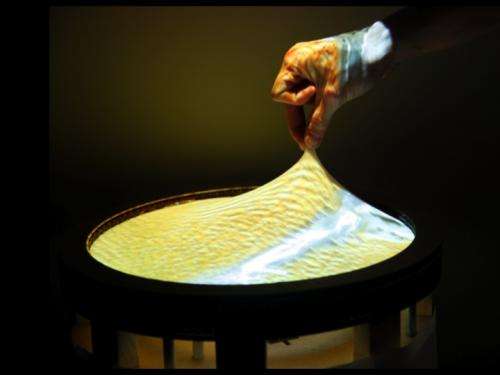April 23, 2013 report
Pinch, prod, pull on stretchy display by MIT creatives (w/ video)

(Phys.org) —What is an Obake? Two definitions have emerged; MIT inventors would enjoy close attention on the newer one. The older definition is that they are creatures in Japanese folklore that shift shapes. The second is an updated, 2013 definition, created in MIT Media Lab quarters. Obake is a highly touchable screen interface that lets you pinch, press, prod, and expand your screen. "What if our screens were elastic?" asks one of the designers, Dhairya Dand. The question that goes with that one is, are you up for a user experience beyond a flat screen? Those are the questions that result from the MIT Media Lab project on a touchscreen interface that can take users into a next-step world of tactile computing. In one of the inventor's words, they provide a new language of interaction.
Dhairya Dand and Rob Hemsley are behind the creation of the Obake, a 2.5 dimensional interface. "Screens as they exist today are flat, 2D and rigid; even the 3D displays we have today are not true 3D - they are optical illusions. We created a 2.5D display that is shape-changing with the help of actuators, depth cameras, projector and a silicone screen," Dand said.
The video for their Obake prototype shows how tactile a display can be, as the hands work to pull mountains up and draw rivers. It's essentially an elastic wonder that is ready for pulling and poking, inviting skills otherwise used for pizza dough. It looks as if you can pinch it; press your finger down and depress the material; expand it, stretch it, and warp shapes.Topographical shapes protrude through the surface.
A depth camera measures hand movements. The materials they used to build Obake: wood, linear actuators, liquid rubber casted into a screen, Kinect, projector. They wrote their software in openFrameworks. And, speaking of glue, openFrameworks is a C++ toolkit which is designed to work as a "general purpose glue," and wraps together a number of libraries. The API is designed to be minimal and easy to grasp. In all, openFrameworks makes it easy to make things with code.
More information: dhairyadand.com/sec/?page=projects&id=obake
© 2013 Phys.org





















